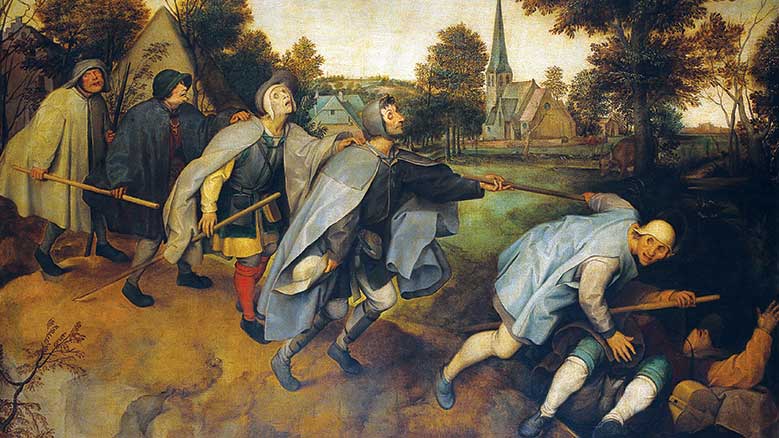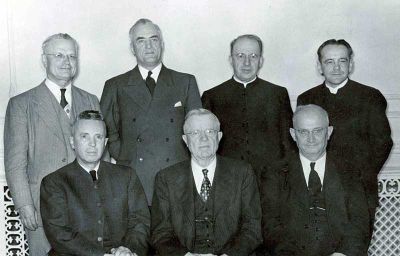
The Blind Leading the Blind, or The Parable of the Blind, by Pieter Bruegel the Elder, 1568.
Iwasn’t always a Quaker. I was born into a big, boisterous Irish Catholic family where there was lots of fun and laughter. In fact, one of my mother’s adages (and she had a whole barrow‐load of them) was that “a little nonsense now and then is relished by the wisest men.” Not that we told jokes as such; it’s that we somehow saw the jokes in life. We relished the ridiculous and the absurd, and there was a pervasive sense of playfulness around words, around ideas, and around situations. Anything was fair game. Well, not quite anything. We weren’t allowed to be unkind, and we didn’t joke about S‐E‐X or anything like that. We were devout too, but somehow we knew that irreverence is not a lack of reverence.
I don’t want to provide a spiritual autobiography, except to say that I moved through Protestantism, where I found a much clearer separation between prayer and playfulness. You could be frivolous and you could be devout, but not at the same time, and there was a kind of conscious earnestness attached to both. Eventually, I ended up among Quakers. Ah, the Quakers.
Perhaps we can be good, do good, and yet have fun at the same time.
We Quakers have a bit of an image problem when it comes to fun and frivolity, and I suspect that goes right back to the beginning. For all his talk of cheerful walking, George Fox was not really much of a cheerful chappy. I think he meant something quite different by the term, but I’m glad he said it. It gives me a certain license somehow. But being a Quaker was a serious business, what with William Penn’s stern warning of No Cross, No Crown, and Thomas Ellwood’s daunting account of his visit to the Peningtons soon after they had become Quakers. He discovered there “so great a change from a free, debonair, and courtly sort of behavior, which we formerly had found in them, to so strict a gravity as they now received us.” No jokes please; we’re Quakers.
There have been some attempts to push back against this. No less a weighty Friend than Thomas Kelly aspired to another way of being Quaker. He had a sense of pervading joy, and speaks of his attempts “to keep one’s inner hilarity and exuberance within bounds.” He goes on to assert that “I’d rather be jolly Saint Francis hymning his canticle to the sun than a dour old sobersides Quaker whose diet would appear to have been spiritual persimmons.[?]” Perhaps we can be good, do good, and yet have fun at the same time. Perhaps weightiness does not have to mean heaviness; simplicity does not have to mean austerity, especially austerity of the soul.
The pleasure of humor transfers to a pleasure in the new and unfamiliar. It encourages us to be adventurous and to take risks: to be creative.
We seem keen at times to prove this about ourselves. We are not humorless. We do have a sense of fun. Our meetinghouse library has a copy of a 1950s publication called Laughter in Quaker Grey.The editor, William Sessions, compiled a selection of anecdotes—real, embellished, apocryphal—which tell funny tales of Quakers, real and imaginary. I think there may have been a later edition as well. More recently, Chuck Fager has produced a similar publication called Quakers Are Funny, and a more strongly argued (well, at least more strongly titled) Quakers Are Hilarious. There are even a couple (that I know) of online groups for Quakers seeking to encourage each other to explore their lighter, more playful selves.
Within such a framework, there are some suitable funny stories I could contribute from my own life. One is a (probably apocryphal) story a dear, old Quaker woman used to tell. A group of youngsters was describing to each other what kind of grace their families would say before meals. When it came to the turn of the little Quaker boy, he explained, “We don’t say grace; we just sit there and smell our food.” (Boom! Boom!)
The second is (as we Aussies would say) a ridgy‐didge true story. We run a thrift shop here in Adelaide, and a customer once asked how that could be. How could we have a Quaker‐run shop? After all, “Quakers are all dead.”
There is humor in the gospels as well, if we allow ourselves to see it as such.
But is there anything to be gained by being humorous? In evolutionary terms, it seems as though there could be. Having a bit of a scan through the literature of evolutionary psychology, I find the idea that humor may indeed be “evolutionarily adaptive.” The theory goes that a significant element of humor is that there’s always a last‐minute twist. Things are brought together that we don’t expect to be together. The final step, the punch line, is a surprise, and somehow that jolt of the unexpected gives us pleasure (the sort of pleasure we call humor). In evolutionary terms, this frees us up to seek other than the usual, predictable answer to situations. The pleasure of humor transfers to a pleasure in the new and unfamiliar. It encourages us to be adventurous and to take risks: to be creative.
And, in fact, there is another whole field of research which shows a connection between humor and creativity. Those who had watched a funny film before attempting a problem‐solving task performed better than those who watched an instructional film on mathematics. There are other positive effects of humor which have been identified as well: humor as tension breaker, as connection maker, as sneaky teacher.
Humor has had a place in religion, or at least in some religions. The laughing Buddha comes to mind. Humor seems to be an essential part of at least some versions of Buddhism. I don’t think I’ve seen an interview with the Dalai Lama where he hasn’t been laughing in delight at the essential humor of life. And the koans of Zen involve a freeing of the mind from the rigidly logical and predictable, such that the disciple arrives at an unexpected, but somehow just right, place: through humor to enlightenment.
There is humor in the gospels as well, if we allow ourselves to see it as such. Jesus’s storytelling and preaching are rich with hyperbole and with the juxtaposition of unexpected elements. The stories are full of the element of surprise. Who would think to imagine the blind leading the blind? A laughable idea. Or a camel struggling to enter the eye of a needle (even if it’s not a needle as we know it). Or people with great beams of wood in their eyes complaining about the splinters in others’ eyes. Or meek people inheriting the earth. It’s not belly‐laugh stuff, but it’s ludicrous and arresting, and—yes—humorous. We could even argue that this very quality of not‐the‐expected is an essential component of the gospel message, and there must be something significant in that.
Humor can be used as a means of undermining others in a way that does not respect that of God within them. It can also be used as an easy way out.
I’ve been speaking as if humor is always a good thing, but of course that is not necessarily so. The same stuff can be used to fashion both swords and plowshares. What presents as humor can be hurtful and destructive—or at least distractive. Humor can be cruel. There is “humor” that belittles, that excludes, that denigrates whole groups through negative stereotyping. Who hasn’t been charged with can’t you take a joke? Humor can be used as a means of undermining others in a way that does not respect that of God within them. It can also be used as an easy way out. It can distract or deflect from a situation that actually needs to be dealt with seriously. Let’s just make a joke and trivialize the issue, so we don’t really need to address it. Humor can indeed do harm. It can be used as a weapon or as an escape, a get‐out‐of‐jail‐free card.
But, even with those caveats, I would like to make a case for our embracing humor in our lives as Friends. Let us collect and laugh together at our funny little anecdotes that point out our peculiar idiosyncrasies and help unite us as a people. There’s also a serious side to this funny business. There is value in the particular quality of humor that welcomes the unexpected and unpredictable. This can be freeing, allowing us to cast aside those constrictions and rigidities that can be both limiting and divisive. It can help nurture a climate where we are open to those Aha! moments where we arrive at the unexpected and unpredicted outcome that is as right as it is surprising. Open, if you like, to the promptings of the Spirit which may seek to take us to places our more cautious tight‐laced selves could not have imagined. And, besides, what fun we could have along the way.














Brussels, Belgium
Fair play to ya’, Kelly O’Regan.
I like what you have to say.
My wife Kate McNally and I are recent Quakers now (as of 2014), as I approach my 80th birthday on God’s earth, fit as a fiddle. She serves as Librarian for our Meeting and we both serve as Friends in Residence at Woodbrooke Study Centre near Birmingham, England.
I belong to another spiritual program which says “We absolutely insist on enjoying life!”
So, keep on keepin’ on, friend!
Daniel Clarke Flynn
Belgium and Luxembourg Yearly Meeting
Newsletter Editor and FWCC‐EMES (Europe and Middle East Section) Representative
Member, QAAD (Quaker Action on Alcohol and Drugs), QUIP (Quakers Uniting in Publications), and
Quakers & Business Group (Convenor, Nominations Committee)
Windhoek
What a delightful article!
Poole Dorset
Brilliant article thank you. I’d like to share it with other friends in our area in News & Views (3 editions per year).
John.
Bournemouth Meeting
Dorset UK
Fairfield, Iowa
Thank you Kerry! A good reminder!